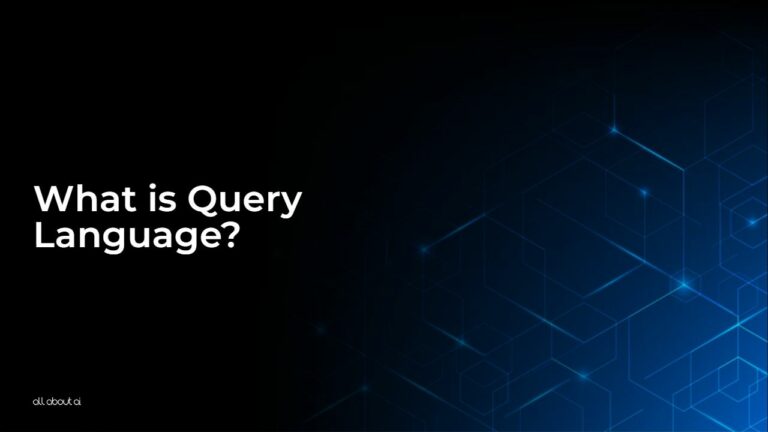Query language is a fundamental aspect of database management and artificial intelligence (AI). It refers to a specialized language used to communicate with databases to manage and manipulate data.
This language is essential for retrieving data from databases and instructing AI algorithms, making it a cornerstone in the field of AI.
Looking to learn more about query languages? Keep reading this article written by the AI enthusiasts at All About AI.
What is Query Language? Fun with Computer Codes!
Query language is like a secret code that helps us talk to computers, especially when we need to find and use information stored in them. Think of it as a special way to ask computers questions or give them instructions to find the data we need.
This special language is really important when we use big collections of information (called databases) or when we work with artificial intelligence (AI), which is like teaching computers to think and learn. It helps us get the information from these databases or tell the AI what to do.
If you want to know more about how we use this language to chat with computers and AI, just keep reading!
How Do Query Languages Function in Databases and AI?

Query languages serve as the medium of communication between users and databases or AI systems. In databases, they are used to retrieve, update, delete, and manage data efficiently.
In the context of artificial intelligence, query languages facilitate the extraction of relevant data from databases, which is crucial for training and operating AI models.
These languages, through their syntax and structure, enable precise and complex data queries, making them indispensable in managing the vast data repositories that AI systems rely on.
How Do Query Languages Enhance AI Efficiency?
Query languages play a pivotal role in enhancing AI efficiency. They enable AI systems to access and interpret vast datasets, thus facilitating better decision-making, pattern recognition, and predictive analysis.
Speeding Up Data Access
Query languages enable quick access to large datasets, reducing the time AI systems spend on data retrieval. This speed is crucial for real-time data processing and analysis in AI applications.
Improving Data Accuracy
By allowing precise data queries, query languages help in retrieving accurate and relevant data. This accuracy is vital for the reliability of AI predictions and decisions.
Enabling Complex Data Analysis
The advanced features of query languages allow for complex data analysis, which is essential for sophisticated AI functions like pattern recognition and predictive analytics.
Facilitating Scalability
As AI systems grow in complexity, query languages provide the scalability needed to handle larger datasets and more complex data structures.
What Makes Query Languages Different From Data Query Languages?
While query languages are primarily designed for database management, data query languages specifically cater to the retrieval of data. The latter focuses on extracting and organizing data based on specific criteria, which is a subset of what general query languages can do.
Here are some more differences between them.
Scope of Functionality
While query languages have a broad range of functionalities including data manipulation, creation, and management, data query languages are specifically focused on data retrieval.
Complexity and Versatility
Query languages are generally more complex and versatile, capable of performing a variety of functions beyond data querying. In contrast, data query languages are simpler, designed primarily for querying data.
Syntax and Structure
The syntax and structure of query languages are often more complex, reflecting their broader range of capabilities. Data query languages tend to have a simpler syntax, tailored to data retrieval tasks.
Target Users
Query languages are used by database administrators, developers, and AI professionals, requiring a deeper understanding of database management. Data query languages, being simpler, are more accessible to a wider range of users.
Integration with AI Systems
Query languages are integral to AI systems for data management and manipulation, whereas data query languages are primarily used for straightforward data retrieval, which may not suffice for complex AI operations.
What Are the Key Uses of Query Languages in AI?

Query languages in AI are primarily used for:
Data Retrieval
They are essential for extracting specific data from large datasets, which is necessary for training and operating AI models.
Data Manipulation
Query languages enable the modification, addition, and deletion of data within AI models, facilitating dynamic learning and adaptation.
Data Analysis
They assist in analyzing and interpreting data, which is crucial for AI in making predictions and informed decisions.
What Are the Innovative Applications of Query Languages in Modern AI?
The applications of query languages in modern AI include:
- Enhancing Machine Learning Models: Query languages provide efficient access to training datasets, enabling the creation of more accurate and sophisticated machine learning models.
- Natural Language Processing: They support natural language processing, improving human-computer interaction by enabling AI to understand and respond to human language queries.
- Business Intelligence Tools: Query languages are used in AI-driven business intelligence tools for advanced data analytics, aiding in decision-making processes.
- Healthcare Data Analysis: In healthcare, query languages facilitate the analysis of patient data, aiding in the development of personalized medicine and predictive diagnostics.
- Smart City Applications: They are used in smart city initiatives, helping in the management and analysis of large-scale urban data for improved city planning and management.
What Challenges Arise in AI With Different Query Languages?
Different query languages can present challenges in AI, such as compatibility issues, learning curve for developers, and optimization complexities in handling diverse datasets.
- Compatibility Issues: Different AI systems may require specific query languages, leading to compatibility challenges in integrating various AI applications.
- Learning Curve for Developers: The diversity of query languages can result in a steep learning curve for developers, affecting the development speed of AI applications.
- Optimization Complexities: Optimizing AI applications for different query languages can be complex, especially when handling large and diverse datasets.
- Maintenance and Support: The use of multiple query languages can complicate maintenance and support, requiring specialized expertise for each language.
- Data Security Risks: Different query languages may have varying levels of security features, posing challenges in ensuring data security and privacy in AI applications.
What Are the Future Trends in Query Language Development?

Future trends in query language development include:
Integration with AI and Machine Learning
Future developments in query languages are expected to include greater integration with AI and machine learning, making query processing more intuitive and efficient.
Advancements in Natural Language Processing
There is a trend towards the development of natural language query languages, simplifying interactions for users and making AI systems more accessible.
Focus on Security and Privacy
As data privacy concerns grow, future query languages are likely to emphasize enhanced security features to protect sensitive data in AI applications.
Scalability and Performance Optimization
With the increasing scale of AI applications, future trends in query language development will likely focus on improving scalability and performance, enabling efficient handling of ever-larger datasets.
Embark on a journey into the realm of artificial intelligence with our thoughtfully assembled glossaries. Whether you’re a novice or an expert, there’s always something fascinating to discover!Want to Read More? Explore These AI Glossaries!
FAQs
What do you mean by query language?
What is an example of a query language?
Is SQL a query language?
What are the 5 types of query language?
Conclusion
Query languages are integral to the functioning and advancement of AI technologies. They enable efficient data management, which is crucial for the development of intelligent systems. As AI continues to evolve, the role of query languages is expected to become even more significant, driving innovation and efficiency in this dynamic field.
This article was written to answer the question, “what is query language.” If you’re looking to learn more about the wider world of AI, read through the rest of the articles in our AI Compendium.





